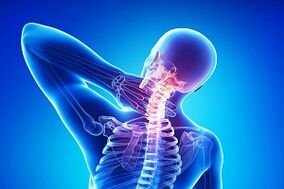Osteochondrosis is a pathology caused by degenerative processes in cartilage tissue.In most cases, stable function of the intervertebral discs is noted, which is why it is most often referred to as spinal osteochondrosis.
Pathogenesis
Firstly, osteochondrosis is associated with a person being in an upright position for a long period of time, which leads to increased load on the spine and intervertebral discs.
With age, the functionality of blood vessels decreases, nutrition becomes more unbalanced, the body ages, which only accelerates the development of pathological processes.

Osteochondrosis is a multifactorial disease;The main requirements for its development can be:
- Work involving vibrations or where posture changes frequently (flexion-extension, twisting, bending, jerky movements);
- lifting weights;
- obesity;
- multiple pregnancy;
- lack of vitamins in the body;
- sedentary lifestyle;
- sleep on a soft mattress;
- poor posture (scoliosis);
- Vertebral instability.
The aggravation of the dystrophic process of intervertebral disc destruction may be associated with intense physical activity (especially without prior warm-up), injuries or skeletal pathologies that change the distribution of the load on the spine.
Characteristic signs of pathology
Numbness and pain as the main symptoms of osteochondrosis can be observed throughout the body or only in the back.The pain increases with sudden movement, physical activity, and in some cases when sneezing or coughing.The body's attempt to protect itself from pain results in increased muscle tension and reduced motor ability.
If a person is not provided assistance and treatment is not started, the pain intensifies even more, spreading to the limbs and limiting their mobility.If the cervical spine is affected, the arms are also affected, and the lumbar spine is affected by the lower limbs.
The symptomatic manifestations differ depending on which part of the spine is affected.
Types and symptoms of osteochondrosis
Pathologies can affect different parts of the spine.Taking into account the localization, osteochondrosis can develop in the cervical (more than 25% of diagnosed cases), lumbar (more than 50%) or thoracic (12%) areas.
The aggravation of the dystrophic process of intervertebral disc destruction may be associated with intense physical activity (especially without prior warm-up), injuries or skeletal pathologies that change the distribution of the load on the spine.
Osteochondrosis of the neck
The spinal cord, arteries (which supply the brain), nerve trunks, and roots (which connect nerves to the arms, lungs, and heart) pass through the neck region.Over the years, neck movements become difficult, especially for people who have no education or who work at a computer for a long time.
Characteristic symptoms of cervical osteochondrosis:
- headaches and heartaches;
- dizziness (possible short-term loss of consciousness associated with impaired blood supply to the brain);
- Numbness and pain in the shoulder joints or arms.
Osteochondrosis of the thoracic region

Pain in the chest area is known to people who carry out physical work frequently and for a long period of time, representatives of “sedentary” professions (architects, designers, drivers).
The main symptoms of osteochondrosis of the thoracic region:
- feeling of having a “stake in the chest”;
- painful sensations in the neck area, between the shoulder blades;
- Numbness of the hands (temporary, long-term);
- hearing and visual impairment;
- increased sweating;
- Headache radiating to the back of the head (often long-lasting, up to 12 hours);
- changes in blood and intracranial pressure;
- Tachycardia and arrhythmia.
A good prevention of thoracic osteochondrosis is correct posture.
Symptoms of lumbar osteochondrosis
Health problems caused by osteochondrosis in the lumbar region are as follows:
- frequent urination;
- numbness of the limbs;
- Dizziness;
- muscle spasms and spasms;
- difficulty moving, bending and turning the body;
- development of scoliosis;
- Pain in the lower back, especially in the morning, immediately after waking up;
- impaired muscle sensitivity and tone.
The pain and its intensity reach their peak in the acute phase of the disease.Their duration can bother a person for several days, but sometimes the pain persists for weeks and even months.As the pathological process in the intervertebral discs progresses, the severity of the symptoms decreases.After 60 years the disease becomes chronic and the pain disappears.
Stages of the disease
Osteochondrosis is a progressive pathology, the transition to any further form occurs gradually.One of the stages is the formation of a hernia, which occurs when the fibrous ring becomes thinner.The rupture causes protrusion of the nucleus and compression of the roots, resulting in increased pain and a reduction in the disc's ability to absorb shock.
The main stages of development of osteochondrosis:
- A person develops characteristic discomfort caused by physical exertion or prolonged stay in one position.The x-ray shows a slight narrowing of the spaces between the vertebrae.
- Loss of disc stability, cartilage tissue extends into the fibrous ring and nerve roots are compressed.An x-ray shows a reduction in the intervertebral distance, displacement of the vertebrae and proliferation of bone tissue.
- Intervertebral hernias occur.The intervertebral disc migrates more and more into the surrounding tissue.Violations lead to damage to nerves and blood vessels.The pain increases, there is numbness and restricted movement of the limbs.
- The intervertebral disc hardens and is replaced by scar tissue.With fibrosis, bone protrusions grow along the edge and the distance between the vertebrae decreases significantly.The mobility of the spine decreases and it appears to ossify.
Diagnosis of osteochondrosis
A preliminary diagnosis is made by a doctor based on the patient's complaints and after a visual examination.Pain and tenderness at certain points, the state of muscle tone, the range of motion and the presence of postural disorders (e.g. signs of scoliosis) are taken into account.
The presence of osteochondrosis and its stage are clarified after carrying out instrumental research methods.First, an x-ray of the part of the spine of interest is prescribed.
After studying the images, the specialist notes:
- whether the intervertebral distance has decreased;
- whether the cartilage tissue is exhausted;
- At what stage is the ongoing pathological process?
If a patient is diagnosed with an intervertebral fracture, an MRI is prescribed.By scanning and visualizing soft tissue layer by layer, a preliminary diagnosis can be confirmed or refuted with high accuracy.
How to treat osteochondrosis?
The treatment of the disease is long-term.The main goal is to relieve pain and muscle tension and, after identifying the provoking cause, to stop the development of the pathological process.
The specialist decides which treatment method is most effective based on the study results and the severity of the existing pathology.Procedure.
Drug treatment of osteochondrosis

The main goal of this type of disease is to stop the inflammatory process, pain, and relieve muscle spasms.This can be achieved by having the patient take:
- Nonsteroidal anti-inflammatory drugs.To reduce the tone of skeletal muscles, muscle spasms and compression of nerve roots, the specialist supplements NSAID drugs with muscle relaxants.
- Vitamin preparations of group B
The optimal duration of treatment is 7-10 days.
Medication is often supplemented by local treatment.Warming ointments or gels containing NSAIDs can be applied to the affected area, which increase blood circulation and metabolism and stop inflammation.External remedies quickly relieve pain because the main active ingredient penetrates the inflammation and begins to “work” immediately.
The use of medication is usually supplemented by exercise therapy, massages, physioreflexology or manual therapy.
The main task of people with osteochondrosis is to reduce the frequency and severity of pain symptoms (especially during an exacerbation).Compliance with the doctor's recommendations and taking medications in combination with physiotherapy exercises will help restore the normal functioning of the spine and avoid surgical intervention.

















































